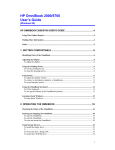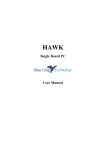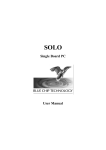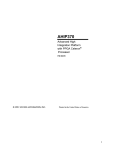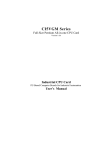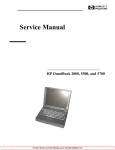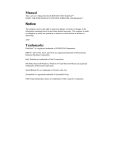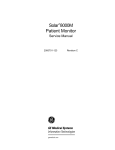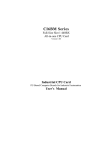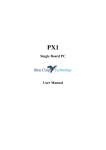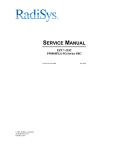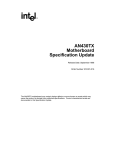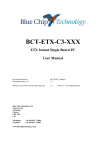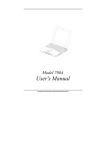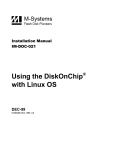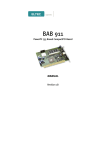Download Half Length Multimedia PC User Manual
Transcript
ATOM
Half Length Multimedia PC
User Manual
ATOM
User Manual
Document Part N°
Document Reference
Document Issue Level
0127-1029
ATOM\docs\01271029.DOC
3.0
Manual covers PCBs with the following Issue
2.x (x is any alpha/digit) and above.
All rights reserved. No part of this publication may be reproduced, stored in any retrieval system, or transmitted, in any form or by any means,
electronic, mechanical, photocopied, recorded or otherwise, without the prior permission, in writing, from the publisher. For permission in the
UK contact Blue Chip Technology.
Information offered in this manual is believed to be correct at the time of printing. Blue Chip Technology accepts no responsibility for any
inaccuracies. The information contained herein is subject to change without notice. There are no express or implied licences granted herein to
any intellectual property rights of Blue Chip Technology Ltd.
All trademarks and registered names acknowledged.
Blue Chip Technology Ltd.,
Chowley Oak, Tattenhall,
Chester, Cheshire,
CH3 9EX
Telephone : 01829 772000 Facsimile : 01829 772001
www.bluechiptechnology.co.uk
Amendment History
Issue
Level
1.0
2.0
3.0
Issue
Date
04/11/98
26/05/99
09/11/00
Author
TGH
TGH
TGH
Amendment Details
First Draft Issue
First Issue
Second Issue – reformat, 69030 added, VCLK
correction, Added DOC and watchdog support
ATOM USER MANUAL
CONTENTS
INTRODUCTION.......................................................................................................................................... 1
MANUAL OBJECTIVES ................................................................................................................................ 1
LIMITATIONS OF LIABILITY ...................................................................................................................... 1
PRECAUTIONS .............................................................................................................................................. 1
Electro-Static Discharges ............................................................................................................................ 1
On-Board Battery ........................................................................................................................................ 1
RELATED PUBLICATIONS........................................................................................................................... 2
TRADEMARKS .............................................................................................................................................. 2
USER GUIDE ................................................................................................................................................ 3
OVERVIEW.................................................................................................................................................... 3
Board Level Features................................................................................................................................... 3
CPU............................................................................................................................................................. 4
Processor socket .......................................................................................................................................... 4
Second Level Cache ..................................................................................................................................... 4
System Memory............................................................................................................................................ 4
BUS Expansion Slots.................................................................................................................................... 4
Electromagnetic Compatibility..................................................................................................................... 5
SPECIFICATION............................................................................................................................................ 5
HARDWARE DESCRIPTION...................................................................................................................... 7
CHIPSET......................................................................................................................................................... 7
82439HX XCELERATED CONTROLLER (TXC) .......................................................................................... 7
PCI/ISA IDE XCELERATOR (PIIX3)............................................................................................................. 7
UNIVERSAL SERIAL BUS (USB).................................................................................................................. 8
I/O CONTROLLER ......................................................................................................................................... 8
IDE Support................................................................................................................................................. 8
SMC 37C932 SUPER I/O CONTROLLER ...................................................................................................... 9
Floppy Controller ........................................................................................................................................ 9
Keyboard/mouse Interface ........................................................................................................................... 9
Real Time Clock, CMOS RAM and Battery .................................................................................................. 9
GRAPHICS SUBSYSTEM ............................................................................................................................ 10
Display Capabilities................................................................................................................................... 10
BIOS ............................................................................................................................................................. 10
System Setup Utility ................................................................................................................................... 10
CONNECTING AN LCD TO ATOM ............................................................................................................ 11
JUMPERS...................................................................................................................................................... 11
CMOS Battery Source (clear CMOS) J1..................................................................................................... 11
Panel Power supply j21.............................................................................................................................. 11
CPU Speed Setting JP6.............................................................................................................................. 12
USER-INSTALLABLE UPGRADES............................................................................................................. 13
System Memory.......................................................................................................................................... 13
EDO DRAM ........................................................................................................................................... 13
Real Time clock Battery Replacement ........................................................................................................ 13
Graphics Memory option............................................................................................................................ 13
SOLID STATE DISK SUPPORT................................................................................................................... 13
Installing the DiskOnChip.......................................................................................................................... 14
Configuring the DiskOnChip as the Boot device ........................................................................................ 14
Configuring the DiskOnChip as the first drive............................................................................................ 14
USING THE ADDITIONAL IO FUNCTIONS .............................................................................................. 15
Watchdog Timer Operation ........................................................................................................................ 15
ADDRESS MAPS.......................................................................................................................................... 16
I/O MAP .................................................................................................................................................... 16
Memory Map.............................................................................................................................................. 17
Blue Chip Technology Limited
0127-1029
ATOM USER MANUAL
CONTENTS
PCI Configuration Space Map ................................................................................................................... 17
Interrupts & DMA Channels ...................................................................................................................... 19
CONNECTORS............................................................................................................................................. 20
Back panel Connectors .............................................................................................................................. 20
Video Connector P18 (15 way condensed D-type) .................................................................................. 20
PS/2 Keyboard Port P19 (6 way mini-din) .............................................................................................. 20
RS232 Serial Port 1 P20 (9 way D-Type)................................................................................................ 20
Ethernet UTP Connector P25 (8 way RJ45 )........................................................................................... 20
Internal I/O Headers & Connectors ........................................................................................................... 21
Primary E-IDE Connector P13 (2X20 Way Header)............................................................................... 21
ECP/EPP Parallel Port JP1 (2X13 way header)..................................................................................... 21
PS/2 Mouse Port JP2 (5 way header) ..................................................................................................... 22
RS232 Serial Port 2 P21 (2x5 way HEADER)......................................................................................... 22
Dual USB Ports JP3 (2X5 way header) .................................................................................................. 22
LCD Primary Connector P11 (2X25 Way 2mm Header) ......................................................................... 22
LCD Secondary Connector for 36 bit panels P24 (2X10 Way 2mm Header) ........................................... 23
Digital Video Option P23 (2X20 Way 2mm Header)............................................................................... 23
CD-Audio Input P7 (4 way box socket)................................................................................................... 23
Audio Connector P8 (2X5 way 2mm box socket)..................................................................................... 23
Floppy Disk Drive Connector P12 (2X17 way header) ........................................................................... 24
RS485 Serial Port 2 P14 (2X5 way header) ............................................................................................ 24
IRDa Connector JP5 (5 way header)...................................................................................................... 24
Battery Connector P1 (4 way header)..................................................................................................... 24
Fan Power Connector J19 (2 way header).............................................................................................. 24
LCD VEE Interface connector JP4 (5 way header)................................................................................. 25
Power Connector J20 (4 way)................................................................................................................. 25
Utility Connector P16 (2X10 way header) ............................................................................................. 25
COAST Cache Connector P3.................................................................................................................. 25
PINOUT OF ISA, PISA AND PCI CONNECTORS....................................................................................... 26
ERROR MESSAGES..................................................................................................................................... 28
BOARD LAYOUT ........................................................................................................................................ 28
Blue Chip Technology Limited
0127-1029
ATOM USER MANUAL
COMPANY PROFILE
COMPANY PROFILE
Blue Chip Technology is a leading specialist PC product manufacturer in Europe.
Blue Chip Technology provides innovation with quality design and manufacturing from a single source.
Based in the North West of England, our purpose built complex contains both advanced research and
development facilities, and manufacturing facilities.
Specialising in the provision of industrial computing and electronic solutions for a wide range of UK and
European organisations, Blue Chip Technology has one of the UK's largest portfolios of industrial PCs,
peripherals and data acquisition cards. This extensive range of products, coupled with our experience and
expertise, enables Blue Chip Technology to offer an industrial processing solution for any application. The
ATOM Single Board PC is the latest addition to our portfolio, providing a cost effective product
development and volume production tool for OEMs.
A unique customisation and specialised system integration service is also available, delivering innovative
solutions to customers problems. The company's success and reputation in this area has led to a number of
large design and manufacturing projects for companies such as GEC Marconi, Aston Martin, Shell and
British Gas.
British Standards Institute approval (BS EN 9001) means that all of Blue Chip Technology's design and
manufacturing procedures are strictly controlled, ensuring the highest levels of quality, reliability and
performance.
Blue Chip Technology are also committed to the single European market and continue to invest in the latest
technology and skills to provide high performance computer and electronic solutions for a world-wide
customer base.
Blue Chip Technology Limited
0127-1029
ATOM USER MANUAL
INTRODUCTION
INTRODUCTION
MANUAL OBJECTIVES
This manual describes in detail the Blue Chip Technology ATOM Single Board processor card.
We have tried to include as much information as possible but we have not duplicated information that is
provided in the standard IBM Technical References, unless it proved to be necessary to aid in the
understanding of the ATOM.
The manual is sectioned and includes a User Guide which will help the non technical user to get the unit up
and running. A Troubleshooting Guide is also included to help when things go wrong.
We strongly recommend that you study this manual carefully before attempting to interface with ATOM or
change the standard configurations. Whilst all the necessary information is available in this manual we
would recommend that unless you are confident, you contact your supplier for guidance.
Please be aware that it is possible to create configurations within the CMOS RAM that make booting
impossible. If this should happen, clear the CMOS settings, (see the description of the Jumper Settings for
details).
If you have any suggestions or find any errors concerning this manual and want to inform us of these, please
contact our Technical Services department with the relevant details.
LIMITATIONS OF LIABILITY
In no event shall Blue Chip Technology be held liable for any loss, expenses or damages of any kind
whatsoever, whether direct, indirect, incidental or consequential, arising from the design or use of this
product or the support materials supplied with this product. If this product proves to be defective, Blue Chip
Technology is only obliged to replace or refund the purchase price at Blue Chip Technology's discretion
according to their Terms and Conditions of Sale.
PRECAUTIONS
It is imperative that precautions are taken to avoid Electro-static discharges, or any maltreatment of the onboard battery.
ELECTRO-STATIC DISCHARGES
The devices on this card can be totally destroyed by static electricity. Ensure that you take necessary static
precautions, ideally wear an approved wrist strap or touch a suitable ground to discharge any static build
up. This should be repeated if the handling is for any length of time.
When carrying the board around, please place it into the anti-static bag in which it came. This will prevent
any static electricity build up.
ON-BOARD BATTERY
This board is fitted with a Lithium battery. Great care should be taken with this type of battery. Under NO
circumstances should :
• the outputs be shorted
• be exposed to temperatures in excess of 100°C
• be burnt
• be immersed in water
Blue Chip Technology Limited
0127-1029
Page 1
ATOM USER MANUAL
INTRODUCTION
• be unsoldered
• be recharged
• be disassembled
If the battery is mistreated in any way there is a very real possibility of fire, explosion, and harm.
RELATED PUBLICATIONS
The following publications will provide useful information related to the Standard Personal Computer and
can be used in conjunction with this manual.
• IBM Personal Computer AT Technical Reference, 1502494, IBM, 1984.
• IBM Personal System/2 and Personal Computer BIOS Interface Technical Reference, 15F0306, IBM,
1987.
• The Programmers PC Sourcebook, Microsoft
• The Winn L. Rosch Hardware Bible, Brady
TRADEMARKS
IBM, PC, AT and PS/2 are trademarks of International Business Machines Corporation (IBM).
Phoenix Pico BIOS is a trademark of Phoenix Inc
Intel is a registered trademark of the Intel Corporation.
All 80x86 and Pentium processors are registered trademarks of Intel Corporation.
K6, K6-2 and 3D-Now! are trademarks of AMD.
C6 and Win Chip are trademarks of IDT.
MSDOS and WINDOWS are registered trademarks of the Microsoft Corporation.
Blue Chip Technology Limited
0127-1029
Page 2
ATOM USER MANUAL
USER GUIDE
USER GUIDE
OVERVIEW
The Blue Chip Technology ATOM single board PC sets new standards for integration of the latest advances
in processor, memory, and I/O technologies. The ATOM PISA complies with the new PISA standard
providing ISA and PCI bus interfaces on a single card. This half card multimedia PC is an ideal platform for
the increasing requirements of today's and tomorrow's embedded applications. The ATOM ISA provides
continued support for legacy ISA backplanes.
The flexible design will accept processors operating at 100, 133, 166, 200, 233, 266 and 300MHz, including
MMX devices. The user may install 256 KB of asynchronous Cache, or 256 KB or 512 KB of Pipeline Burst
Cache RAM in the form of a COAST (Cache On A STick) Module. The memory sub-system is designed to
support up to 256MB of EDO DRAM (for improved performance) or standard Fast Page DRAM in standard
72-pin SIMM sockets. A socket accommodates the CPU (turned-pin or SZIF).
The ATOM single board PC utilises Intel’s Triton 82430HX PCIset to provide increased integration and
performance over other single board PC designs. The Triton PCIset contains an integrated PCI Bus
Mastering IDE controller with a high performance IDE interface allowing up to two IDE devices (such as
hard drives, CD-ROM readers, etc.). The SMC 37C932 Super I/O controller integrates the standard PC I/O
functions: floppy interface, two FIFO serial ports, one EPP/ECP capable parallel port, a Real Time Clock,
keyboard and mouse (PS/2) controller.
The ATOM also provides for driving up to twenty external ISA (and four PCI expansion slots - PISA version
only).
In addition to superior hardware capabilities, a full set of software drivers and utilities are available to allow
advanced operating systems such as Windows™ 95 to take full advantage of the hardware capabilities.
Features such as bus mastering IDE, Windows™ 95/98 ready Plug and Play, Advanced Power Management
(APM) are available for the ATOM.
BOARD LEVEL FEATURES
• SPGA socket supporting 75 - 300 MHz operation
• On-board 3.3 V CPU voltage regulator
• Intel Triton 82430 PCIset chipset:
82439HX Xcelerated Controller (TXC)
PIIX3 PCI ISA IDE Accelerator (PIIX3) bridge
• 256KB or 512 KB PipeLine Burst Level 2 cache or 256 KB Asynchronous Level 2 cache using
plug-in COAST connector
• Two SIMM sockets providing up to 256MByte of EDO or FPM DRAM
• C&T 69000 PCI CRT/LCD graphics controller with 2 Mbytes or 69030 with 4MB of video
memory
• PCI and ISA expansion busses via a PISA connector or ISA only via ISA connector
• SMC 37C932 I/O controller providing:
Dual PCI IDE interfaces
Dual floppy interface
EPP/ECP bi-directional parallel interface
• PCI 100/10 base-T Ethernet controller
• Dual USB ports
• Stereo sound (SoundBlaster™ compatible )
• Dual RS232 serial ports. RS422/485/IRDA port. option on the second serial port.
• Real-time clock with on-board battery
• PS/2 mouse and keyboard connectors
Blue Chip Technology Limited
0127-1029
Page 3
ATOM USER MANUAL
USER GUIDE
• Plug-in M-Systems Flash modules.
• Drive for up to 20 ISA and 4 PCI cards (PISA version)
CPU
The ATOM single board PC is designed to operate with Pentium-class Processors running at 2.2, 2.8, 2.9
or 3.3 Volts. An on-board voltage regulator circuit provides the required voltage for the processor from the
incoming 5 volt power supply.
The Pentium processor maintains full backward compatibility with the 8086, 80286, i386 and Intel486
processors. It supports both read and write burst mode bus cycles, and includes separate on-chip code and
data caches which employ a write-back policy. Also integrated into the Pentium processor is an advanced
numeric co-processor which significantly increases the speed of floating point operations, whilst
maintaining backward compatibility with Intel486 math co-processor and complying to ANSI/IEEE
standard 754-1985.
PROCESSOR SOCKET
SZIF: Processor replacement requires the careful use of a flat blade screwdriver. A heatsink and fan will
be required for many of the processors. These will make CPU fitting difficult because of their placement,
especially if they reduce the mechanical advantage of the screwdriver. The screwdriver can be cranked to
overcome this by putting a bend in it at the point it contacts the edge of the CPU. 3.5mm screwdrivers
have been found to be ideal.
Insert the CPU carefully observing the missing pin of the polarisation corner (inspect the pins for
alignment first). Place the screwdriver all the way into the special aperture in the socket between CPU and
large capacitors. Using only the flat of the blade against the CPU, lever the CPU away from the capacitors
until a sharp click indicates proper location. Check that the CPU now sits as far towards the memory end
of the socket as possible. The edge should rest against the plastic by the extraction screwdriver aperture.
Removal is an identical operation using the aperture on the memory side and levering towards the
capacitors, followed by easy lifting out of the socket.
Turned-Pin: Ensure pins are straight before insertion. Take care not to damage adjacent components
during extraction.
SECOND LEVEL CACHE
A second level cache using the COAST connector can complement the Pentium processor’s internal cache.
Pipeline Burst SRAM provides performance similar to expensive Synchronous Burst SRAMs for only a
slight cost premium over the slower performing Asynchronous SRAMs. With the Triton chipset, the
performance level of Pipeline Burst and Synchronous SRAMs is identical.
SYSTEM MEMORY
The ATOM single board PC provides two 72-pin SIMM sites for memory expansion. The sockets support
1M x 32 (4 MB), 2M x 32 (8 MB), 4M x 32 (16 MB), 8M x 32 (32 MB), 16M x 32 (64 MB) and 32MB x
32 (128 MB) single-sided or double-sided SIMM modules. Minimum memory size is 8 MB and
maximum memory size, using two 32MB x 32 SIMM modules, is 256 MB. Memory timing requires 70 ns
fast page devices or, for optimum performance, 60nS EDO DRAM. If the memory bus speed is 60 MHz or
slower (75MHz, 90MHz, 120MHz, 150MHz or 180MHz Pentium Processor speed), 70ns EDO DRAM
may be used. If the memory bus speed is 66 MHz, 60 ns DRAM should be used. Additionally, 36-bit
SIMM modules may be used to provide either standard parity operation or the parity circuitry can be used
by the HX chipset to provide ECC correction. EDO DRAM is designed to improve DRAM read
performance. Both sockets must be occupied with identical SIMM types as the two sockets are arranged in
a bank which provides a 64-bit wide data path. There are no jumper settings required for the memory size
or type, this is automatically detected by the system BIOS.
BUS EXPANSION SLOTS
Blue Chip Technology Limited
0127-1029
Page 4
ATOM USER MANUAL
USER GUIDE
The ATOM is designed for use in an embedded application and provides expansion via PISA or ISA edge
connectors. The PISA version can plug into a suitable backplane to drive up to 20 ISA bus expansion cards
and 4 PCI expansion cards. The ISA version can drive up to 20 ISA bus expansion cards.
ELECTROMAGNETIC COMPATIBILITY
This product meets the requirements of the European EMC Directive (89/336/EEC) and is eligible to bear
the CE mark.
ATOM has been assessed operating in a Blue Chip Technology PC. However, because the board can be
installed in a variety of computers, certain conditions have to be applied to ensure that the compatibility is
maintained. Subject to those conditions, it meets the requirements for an industrial environment (Class A
product).
• The board must be installed in a computer system chassis which provides screening suitable for an
industrial environment.
• Any recommendations made by the computer system manufacturer/supplier must be complied with
regarding earthing and the installation of boards.
• The board must be installed with the optional back plate securely screwed to the chassis of the
computer to ensure good metal-to-metal (i.e. earth) contact.
• Most EMC problems are caused by the external cabling to boards. It is imperative that any external
cabling to the board is totally screened, and that the screen of the cable connects to the metal end
bracket of the board and hence to earth. It is recommended that round screened cables with a braided
wire screen are used in preference to those with a foil screen and drain wire. Use metal connector
shells which connect around the full circumference of the screen: they are far superior to those which
earth the screen by a simple “pig-tail”.
• The keyboard and mouse will play an important part in the compatibility of the processor card since
they are ports into the board. Similarly, they will affect the compatibility of the complete system. Fully
compatible peripherals must be used otherwise the complete system could be degraded. They may
radiate or behave as if keys/buttons are pressed when subject to interference. Under these
circumstances it may be beneficial to add a ferrite clamp on the leads as close as possible to the
connector. A suitable type is the Chomerics type H8FE-1004-AS.
• Ensure that the screens of any external cables are bonded to a good RF earth at the remote end of the
cable.
Failure to observe these recommendations may invalidate the EMC compliance.
Warning
This is a Class A product. In a domestic environment this product may cause radio
interference in which case the user may be required to take adequate measures.
SPECIFICATION
ATOM Power
Requirement
+5 V ± 5%
+12 V ± 5%
+3.3 V ± 5%
-5 V ± 5%
-12 V ± 5%
Required for processor operation.
Required for Network /Audio.
Not required for board operation.
The ISA, & PCI voltage
rails are linked on board.
Typical System
Blue Chip Technology Limited
0127-1029
Page 5
ATOM USER MANUAL
Consumption
USER GUIDE
3.5A 5V
0.15A 12V
K6-2/300, 16 MB RAM, 256 KB
cache
2.0A 5V
0.15A 12V
C6 200, 32MB RAM, 256KB cache
IDT C6MP200 3.3V 66MHz bus.
Temperature
Non-Operating -40°C to +70°C
Operating
+0°C to +55°C
(min. airflow of 100 lfm)
Shock
Non-Operating Half sine, 2ms, 1 m drop
Vibration
Non-Operating 5 Hz - 500 Hz, 3.1 g RMS random
Operating
10 Hz - 500 Hz, 1.0 g RMS random
EMC
Emissions
Immunity
EN55022 (A)
EN50082-2 in a Blue Chip ICON Industrial PC Chassis
MTBF
Calculated
>100,000 Hrs
Dimensions
Board only
338 x 122 mm {40mm height with COAST – large DRAM or large
heatsink may affect this}
Power Consumption figures given are for typical configurations.
This information is preliminary and is provided only as a guide to calculating approximate total system
power usage when additional resources are added.
Blue Chip Technology Limited
0127-1029
Page 6
ATOM USER MANUAL
HARDWARE DESCRIPTION
HARDWARE DESCRIPTION
CHIPSET
The Intel 82430HX PCIset consists of the 82439HX Xcelerated Controller (TXC) and one 82371SB
PCI/ISA IDE Xcelerator (PIIX3) bridge chip.
82439HX XCELERATED CONTROLLER (TXC)
The 82439HX provides all control signals necessary to drive a second level cache and the DRAM array,
including multiplexed address signals. The TXC also controls access to memory and generates snoop
controls to maintain cache coherency. The TXC comes in a 324-pin BGA package and includes the
following features:
•Microprocessor interface control
•Integrated L2 write-back cache controller
Pipeline burst SRAM
256 KB direct-mapped
•Integrated DRAM controller
64 bit path to memory
Support for EDO and fast page DRAM
Parity and non-parity support
•Fully synchronous PCI bus interface
25/30/33 MHz bus speed
PCI to DRAM > 100 MB/sec
Up to four PCI masters in addition to the PIIX3
PCI/ISA IDE XCELERATOR (PIIX3)
The PIIX3 provides the interface between the on-board PCI and ISA buses and integrates a dual channel
fast IDE interface capable of supporting two devices. The PIIX3 integrates seven DMA channels, one 16bit timer/counter, two eight-channel interrupt controllers, PCI-to-AT interrupt mapping circuitry, NMI
logic, ISA refresh address generation, and PCI/ISA bus arbitration circuitry together onto the same device.
The PIIX3 comes in a 208-pin QFP package and includes the following features.
•Interface between the PCI and ISA buses
•Universal Serial Bus controller
Host/hub controller
•Integrated fast IDE interface
Support for two devices
PIO Mode 4 transfers up to 16 MB/sec
Blue Chip Technology Limited
0127-1029
Page 7
ATOM USER MANUAL
HARDWARE DESCRIPTION
Integrated 8 x 32-bit buffer for bus master PCI IDE burst transfers
Bus master mode
•PCI 2.1 compliant
•Enhanced fast DMA controller
•Interrupt controller and steering
•Counters/timers
•SMI interrupt logic and timer with fast on/off mode
UNIVERSAL SERIAL BUS (USB)
The ATOM single board PC features two USB ports available via cable set. The ports permit the direct
connection of two USB peripherals without an external hub. If more devices are required, an external hub
can be connected to either of the built-in ports. ATOM fully supports the standard universal host controller
interface (UHCI) and uses standard software drivers that are UHCI-compatible. Features of the USB
include:
•Self-identifying “hot pluggable” peripherals
•Automatic mapping of function to driver and configuration
•Support for isochronous and asynchronous transfer types over the same set of wires
•Support for up to 127 physical devices
•Guaranteed bandwidth and low latencies appropriate for telephony, audio, and other applications
•Error handling and fault recovery mechanisms built into protocol
NOTE
Computer systems that have an unshielded cable attached to the USB port might not meet FCC Class B
requirements, even if no device or a low speed (sub-channel) USB device is attached to the cable. Use
shielded cable that meets the requirements for high speed (fully rated) devices.
I/O CONTROLLER
IDE SUPPORT
The ATOM single board PC provides one high performance bus-mastering PCI IDE interface capable of
supporting PIO Mode 3 and Mode 4 devices. The system BIOS supports Logical Block Addressing (LBA)
and Extended Cylinder Head Sector (ECHS) translation modes as well as AT API (e.g. CD-ROM) devices
on the IDE interface. Detection of IDE device transfer rate and translation mode capability is
automatically determined by the system BIOS.
In the Windows™ 95/98 environment, a driver can allow the IDE interface to operate as a PCI bus master
capable of supporting PIO Mode 4 devices with transfer rates up to 16MB/sec while minimising the
system demands upon the processor. Normally, programmed I/O operations require a substantial amount
of CPU bandwidth. In true multi-tasking operating systems like Windows™ 95/98, the CPU bandwidth
freed up by using bus mastering IDE can be used to complete other tasks while disk transfers are
occurring.
Microsoft will provide this driver for Windows™ 95/98, other software vendors may make drivers
Blue Chip Technology Limited
0127-1029
Page 8
ATOM USER MANUAL
HARDWARE DESCRIPTION
available for other operating systems.
Detailed information on the PCIset is available in the Intel 82430 PCIset data sheet.
SMC 37C932 SUPER I/O CONTROLLER
Control for the integrated serial ports, parallel port, floppy drive, RTC and keyboard controller is
incorporated into a single component, the SMC 37C932. This component provides:
•Two powered NS16C550-compatible UARTs with send/receive 16 byte FIFO
•Multi-mode bi-directional parallel port
- Standard mode; IBM and Centronics compatible
- Enhanced Parallel Port (EPP) with BIOS/Driver support
- High Speed mode; Extended Capabilities Port (ECP) compatible
•Industry standard floppy controller with 16 byte data FIFO (2.88 MB floppy support)
•Integrated Real Time Clock
•Integrated 8042 compatible keyboard/mouse controller
The 37C932 is normally configured by the BIOS automatically, however configuration of these interfaces is
possible via the CMOS set-up program that can be invoked during boot-up. The serial ports can be enabled
as various standard COM ports, or disabled. The parallel port can be configured as normal, bi-directional,
EPP/ECP, or disabled. The floppy interface is also configurable.
Header connectors located near the top of the board allow cabling to use these interfaces. Take care to
observe the polarity of the headers. Pin 1 is placed at the metal bracket end of the board on all the open
headers.
FLOPPY CONTROLLER
The 37C932 is software compatible with the DP8473 and 82077 floppy disk controllers.
The floppy interface can be configured for 360 KB or 1.2 MB 5¼" media or for 720 KB, 1.44 MB, or 2.88
MB 3½" media in the BIOS set-up. By default, the Floppy A interface is configured for 1.44 MB and
Floppy B is disabled.
KEYBOARD/MOUSE INTERFACE
A PS/2 keyboard/mouse connector is located on the back panel side of the single board PC. A splitter cable
allows mouse and keyboard connection, else only the keyboard occupies this connector. The mouse
interface is also available through a polarised header. A Polyswitch resetable fuse protects the 5V lines to
these connectors. Care must be taken to turn off the system power before installing or removing a keyboard
or mouse, otherwise the fuse may trip. The Polyswitch will reset itself once the fault condition is cleared
and the power to the circuit is removed, allowing it to cool.
The integrated 8042 microcontroller contains the AMI Megakey keyboard/mouse controller code which,
besides providing traditional keyboard and mouse control functions, supports Power-On/Reset (POR)
password protection. The POR password can be defined by the user in the Setup program. The keyboard
controller also provides the facility for a <CTRL><ALT><DEL> "hot key" sequence to perform a system
software reset. It performs this by jumping to the beginning of the BIOS code and running the POST
operation.
REAL TIME CLOCK, CMOS RAM AND BATTERY
The integrated Real Time Clock (RTC) is DS1287 and MC146818 compatible and provides a time of day
clock, 100-year calendar with alarm features. The RTC can be set via the BIOS SETUP program. The
RTC also supports 242 bytes of battery-backed CMOS RAM in two banks which is reserved for BIOS use.
The CMOS RAM can be set to specific values or cleared to the system default values using the BIOS SETUP program. Also, the CMOS RAM values can be cleared to the system defaults by using a configuration
jumper on the single board PC. The appendix lists the jumper configurations.
Blue Chip Technology Limited
0127-1029
Page 9
ATOM USER MANUAL
HARDWARE DESCRIPTION
An on-board Lithium battery provides power to the RTC and CMOS memory. The battery has an
estimated lifetime of three years if the board remains unpowered. When the system is powered up, power
is drawn from the power supply to extend the life of the battery.
ATOM is Year 2000 compliant
GRAPHICS SUBSYSTEM
The ATOM single board PC is provided with the very latest C&T 69000 or 69030 graphics controller with 2
or 4 MB of graphics memory respectively. Both CRT and LCD interfaces are provided. ATOM supports a
wide variety of monochrome and colour Single-Panel, Single-Drive (SS) and Dual-Panel, Dual Drive (DD)
passive STN and active matrix TFT/MIM LCD, EL and plasma panels. ATOM supports a wide range of
panel resolutions.
The 69000 and 69030 have a 32-bit graphics engine that provides acceleration for scaling the video display
without compromising picture quality or frame rate. Hardware acceleration for graphics functions such as
line draws, System-to-screen and screen-to-screen BitBLTs, ROPs, which optimise performance operation
under Windows™ and other GUI environments.
Note that Chips and Technology products, previously a part of Intel Corporation, are now manufactured by
Asiliant Technologies.
DISPLAY CAPABILITIES
The 2MB of video memory can support a variety of resolutions.
The representation of each picture element (pixel) is key to working out capability.
256 colours requires 8 bits (1byte), 64K colours 16 bits (2bytes), 16M colours 24 bits (3bytes).
So 640x480x16M colours requires 640x480x3 bytes = 921600; easily fits into our 2,097,152 bytes of
memory.
The drivers supplied from C&T also need to support the desired resolution. These generally support
640x480x16M, 800x600x16M, 1024x768x64K, 1280x1024x256 and 1600x1200x256. However, 16:9 format
plasma panel and portrait mode have been provided previously.
The 69030’s 4MB of video memory allows higher resolutions/colour depth or independent CRT/panel
displays. Resolutions available are up to 1280x1024x16M and 1600x1200x64K in single display mode.
Be aware that driving older or cheaper monitors beyond their capabilities can destroy them. LCD panels can
also be easily damaged!
Later BIOSs allow panel choice to be made in setup. This was previously achieved by flash update.
BIOS
The ATOM single board PC uses a Phoenix BIOS and a C&T Video BIOS both of which are stored in
EPROM/Flash. In addition to the System and Video BIOSs, the EPROM also contains the Setup utility,
Power-On Self Tests (POST), and the PCI auto-configuration utility. This single board PC supports system
BIOS shadowing, allowing the BIOS to execute from 64-bit on-board write-protected DRAM.
The BIOS displays a sign-on message during POST identifying the type of BIOS and a revision code.
SYSTEM SETUP UTILITY
The ROM-based Setup utility allows the configuration to be modified without opening the system for most
basic changes. The Setup utility is accessible only during the Power-On Self Test (POST) by pressing the
<F2> key after the POST memory test has started and before boot begins. A prompt may be enabled that
informs users to press the <F2> key to access Setup. Deep power-down displays may not light up in time
Blue Chip Technology Limited
0127-1029
Page 10
ATOM USER MANUAL
HARDWARE DESCRIPTION
to display this message. See the BIOS user manual for further details.
CONNECTING AN LCD TO ATOM
Unfortunately, connecting an LCD panel to a PC is not as simple as it is for a CRT. At the time of writing
this manual there is still no universally accepted standard interface for LCDs. We strongly recommend that
if you are in any doubt about connecting a LCD panel to ATOM you contact our Technical Services team
with full details of the target display. ALWAYS check your wiring/voltage setting before you switch on.
JUMPERS
Very few jumpers are used on the board to select various options. Most of the configuration is achieved
through software set-up. Some of the jumpers are factory set to suit particular semiconductor options. These
must not be disturbed, or damage to the board may ensue.
Table of Jumpers
JUMPER
J1
AREA OF INFLUENCE
CMOS Battery Support
JP6
CPU and PCI bus speed plus
CPU internal speed
Panel voltage supply
J21
LINK
None
CLR
NORM
ACTION
Not Allowed
Clear CMOS RAM
Use on-board battery
See Jumper Section
3V/5V
3.3V supply
5V supply
CMOS BATTERY SOURCE (CLEAR CMOS) J1
CMOS Clear J1
Normal
Clear
This jumper is used to clear the CMOS RAM in the event that the contents become corrupt. It selects the
source of backup power to the CMOS RAM, and also allows the CMOS to be cleared down to the default
settings.
Fitting the link to the “CLR” position with the power off, allows on-board capacitors to discharge and will
reset the CMOS memory. The jumper should then be returned to the “NORM” position to restore normal
operation.
PANEL POWER SUPPLY J21
This sets the power supplied to the panel interface to 5V or 3.3V.
= Pin 1
LCD Panel Supply J21
J1/J21: Link two pins as appropriate without power applied. Orientations as in diagrams of
5V
board outline pError! Bookmark not defined.. BUS Connectors
3.3V
Blue Chip Technology Limited
0127-1029
Page 11
ATOM USER MANUAL
HARDWARE DESCRIPTION
CPU SPEED SETTING JP6
This set of jumpers is provided to set the CPU internal speed and the CPU external bus speed.
The external bus speed is always as shown in the tables in this document.
Unfortunately the CPU manufacturers do not have any consistency of settings for particular multiplication
settings - each CPU type requires information from the data sheet! Many common, current values have been
listed in this document but other requirements can be determined by understanding the BF[2-0] operation:
inserting a jumper sets the signal to logical low (0V).
BF2 1 0
F1 0
Pin 1
0 = Jumper present
1 = Jumper absent
Host Bus Speeds available (JP) = Jumper Present
F1
F0
Host Bus Speed
PCI Bus Speed
0(JP)
0(JP)
50MHz
25MHz
1
0(JP)
60MHz
30MHz
0(JP)
1
66MHz
33MHz
1
1
Not allowed
Common Processor multiplier jumper settings
(JP) = Jumper Present
BF2
BF1
BF0
0(JP)
0(JP)
0(JP)
0(JP)
1
1
1
1
0(JP)
0(JP)
1
1
0(JP)
0(JP)
1
1
0(JP)
1
0(JP)
1
0(JP)
1
0(JP)
1
P
2.5
3
2
1.5
MMX
2.5
3
2
3.5
C
6
5
4
3
2
4
K6(-2)[0:7]
K6(-2)[F:8]
4.5
5
4
5.5
2.5
3
2
3.5
4.5
5
4
5.5
2.5
3
6
3.5
The internal CPU speed is expressed as a multiplication of this frequency.
Internal CPU speed from Host Bus Speed
Multiplier
50MHz
60MHz
66MHz
1.5
75
90
100
2
100
120
133
2.5
125
150
166
3
150
180
200
3.5
175
210
233
4
200
240
266
4.5
225
270
300
5
250
300
333
5.5
275
330
366
6
300
360
400
Blue Chip Technology Limited
0127-1029
Page 12
ATOM USER MANUAL
HARDWARE DESCRIPTION
USER-INSTALLABLE UPGRADES
SYSTEM MEMORY
The table shows the possible memory combinations. ATOM will support both Fast Page DRAM or EDO
DRAM SIMMs, but they cannot be mixed. Parity/Error Correction is supported when using parity SIMMs
(x36).
SIMM requirements are 70ns Fast Page Mode or 60nS EDO DRAM (70 ns EDO may be used with a 60
MHz or slower external CPU clock) with tin-lead connectors.
SIMM 1,2 (BANK A)
SIMM TYPE (AMOUNT)
1M X 32 (4 MB)
2M X 32 (8 MB)
4M X 32 (16 MB)
8M X 32 (32 MB)
16M X 32 (64 MB)
32M X 32 (128 MB)
TOTAL SYSTEM
MEMORY
8 MB
16 MB
32 MB
64 MB
128 MB
256 MB
Note: SIMMs may be parity (x 36) or non-parity (x 32)
EDO DRAM
Extended Data Out (or Hyper Page) DRAM is designed to improve the DRAM read performance. EDO
DRAM holds the memory data valid until the next CAS# falling edge, unlike standard fast page mode
DRAM which tri-states the memory data when CAS# negates to precharge for the next cycle. With
EDO, the CAS# precharge overlaps the data valid time, allowing CAS# to negate earlier while still
satisfying the memory data valid window time.
REAL TIME CLOCK BATTERY REPLACEMENT
The on-board battery may be replaced using a Duracell DL2032 3 volt button cell, or equivalent.
GRAPHICS MEMORY OPTION
The C&T B69000 has 2 MB of DRAM installed for graphics. The B69030 has 4MB of memory. These are
build options – no upgrade is possible.
SOLID STATE DISK SUPPORT
The ATOM supports the use of M-Systems’ DiskOnChip 2000 or DiskOnChip Millennium Flash Modules
as solid-state disks. The notes below detail the use of the device with MS-DOS. If support is required for
other operating systems, please consult Blue Chip Technology Technical Services, or M-Systems web-site at
www.m-sys.com, for drivers and application notes.
The DiskOnChip 2000 and Millennium contain a built-in copy of the M-Systems industry-standard TrueFFS
software, which allows the DiskOnChip to operate as a standard disk drive. The DiskOnChip may also
contain the operating system thereby permitting systems to boot without a hard disk. The DiskOnChip may
also be configured as the boot device in systems with a hard disk (see the section “Configuring the
DiskOnChip as the First Drive”).
The DiskOnChip is a self-contained device, the installation of which does not necessarily require any
software installation. The basic design of the DiskOnChip allows for full upward and downward
compatibility by supporting an unlimited capacity. Future DiskOnChip devices with higher densities will be
fully compatible with today’s capacities of 2 to 288 MBytes, and the standard DiskOnChip socket.
Blue Chip Technology Limited
0127-1029
Page 13
ATOM USER MANUAL
HARDWARE DESCRIPTION
INSTALLING THE DISKONCHIP
Before installing or removing the DiskOnChip, please read the section on Electro-Static Discharges at the
beginning of this manual. It is essential that you discharge any static electricity from your body before
touching the board or DiskOnChip module. Use the following procedure to install the DiskOnChip:
• Align pin 1 on the DiskOnChip with pin 1 of the socket (adjacent to the battery).
• Push the DiskOnChip into the socket carefully until it is fully seated.
• Check that the DiskOnChip is installed securely, and that there are no bent pins.
Caution: The DiskOnChip may be permanently damaged if installed incorrectly!
To install the DiskOnChip as drive C on a system without a hard disk, set the CMOS setup of drive C to
“not installed” (indicating that no physical magnetic disk is installed), and reboot the computer. The
DiskOnChip will install as drive C. The DiskOnChip should then be formatted with the System files in
order for it to be a bootable drive. See “Configuring the DiskOnChip as the BOOT device” below.
To install the DiskOnChip as drive D on a system with a hard disk, reboot the system, and the
DiskOnChip will automatically install as drive D.
To install the DiskOnChip as Drive C on a system with a hard disk, see below “Configuring the
DiskOnChip as the First Drive”.
CONFIGURING THE DISKONCHIP AS THE BOOT DEVICE
To configure the DiskOnChip as the boot device, the operating system files have to be copied to it.
Copying the operating system files into DiskOnChip is done in exactly the same way as any other hard
disk. The following is an example of a typical initialisation process:
• Set the DiskOnChip as a regular drive in your system (not a boot drive).
• Install a bootable floppy diskette in drive A and boot the system.
• At the DOS prompt, type SYS C: to transfer the DOS system files to the DiskOnChip (assuming the
DiskOnChip is installed as drive C).
• Copy any files needed into the DiskOnChip.
• Remove the floppy diskette and reboot the system.
The system will boot from the DiskOnChip, and will allow you to run and access any files that have been
copied into the DiskOnChip.
CONFIGURING THE DISKONCHIP AS THE FIRST DRIVE
The DiskOnChip can be configured to be installed as the last drive (default), or as the first drive in the
system. When configured as the last drive, the DiskOnChip is installed as disk D if there is one other hard
drive installed, and as drive C if no other hard disk is installed. When configured as the first drive, the
DiskOnChip is always installed as drive C. The DiskOnChip is shipped from the factory, configured to
install as the last drive. To configure the DiskOnChip to be installed as the first drive, proceed as follows:
• Boot the system and make sure the DiskOnChip is installed correctly as drive D
• At the DOS prompt type: DUPDATE D: /FIRST /S:DOC123.EXB
After re-booting the system, the DiskOnChip will appear as drive C:
Blue Chip Technology Limited
0127-1029
Page 14
ATOM USER MANUAL
HARDWARE DESCRIPTION
USING THE ADDITIONAL IO FUNCTIONS
WATCHDOG TIMER OPERATION
The ATOM includes a watchdog timer circuit, which may be used to monitor software or processor
hardware failure. The time-out period of the watchdog is fixed at 500 milliseconds. It may be enabled or
disabled by using the software interrupt at INT 50h.
Note that the watchdog is disabled following a power on or a reset sequence.
The following code demonstrates the control of the watchdog timer.
Enable/Disable Watchdog
Use the software interrupt as follows:
Calling Registers:
AH = 05
AL = 01 to enable, 00 to disable
Perform INT 50h.
Return Registers:
AH = 00 (success) or FF (failure), and
Carry Flag is clear if successful, set if unsuccessful
Refresh Watchdog
Use the software interrupt as follows at least once every 500 milliseconds:
Calling Registers:
AH = 06
Perform INT 50h.
Return Registers:
Blue Chip Technology Limited
None
0127-1029
Page 15
ATOM USER MANUAL
HARDWARE DESCRIPTION
ADDRESS MAPS
I/O MAP
The following table lists the I/O addresses used by single board PC devices. Some of these devices may not
be present in all configurations. Some devices (serial ports, parallel ports etc.) may be configured for
various addresses or disabled. These I/O locations are listed in the Variable Resources column.
ADDRESS
(HEX)
0000 - 000F
0020 - 0021
002E - 002F
0040 - 0043
0060
0061
0064
0070, bit 7
0070, bits 6:0
0071
0080 - 008F
00A0 - 00A1
00B2 - 00B3
SIZE
Bytes
16
2
2
4
1
1
1
1 bit
7 bits
1
16
2
2
00C0 - 00DE
00F0
0100 - 0107
0170 - 0177
01F0 - 01F7
0200 - 0207
0220
0278 - 027B
02E8 - 02EF
02F8 - 02FF
0376-377
0378 - 037F
0388
03B0 - 03BB
03BC - 03BF
03C0 - 03DF
03E8 - 03EF
03F0 - 03F5
03F6
03F7 (Write)
03F7, bit 7
03F7, bits 6:0
03F8 - 03FF
LPT + 400h
31
1
8
8
8
8
4
4
16
8
6
1
1
1 bit
7 bits
8
3
04D0 - 04D1
0CF8 - 0CFC*
0CF9
0CFC - 0CFF
FFA0 - FFA7
FFA8 - FFAF
FF00-FF07
2
4
1
4
8
8
8
FIXED RESOURCES
VARIABLE
RESOURCES
PIIIX - DMA 1
PIIIX - Interrupt Controller 1
Ultra I/O configuration registers
PIIIX - Timer 1
Keyboard Controller Data Byte
PIIIX - NMI, speaker control
Kbd Controller, CMD/STAT Byte
PIIIX - Enable NMI
RTC, Address
RTC, Data
PIIIX - DMA Page Register
PIIIX - Interrupt Controller 2
PIIIX - APM Control / Status
Interrupt Controller 2
PIIIX - DMA 2
Reset Numeric Error
Reserved for Board Confign.
Primary IDE Channel
Gameport Joystick
Audio
4
8
8
2
8
Serial Port 2
Parallel Port 1
Audio
C&T69000/69030
C&T69000/69030
Floppy Channel 1
Pri IDE Chan Cmnd Port
Floppy Chan 1 Cmnd
Floppy Disk Chg Chan 1
Pri IDE Chan Status Port
Serial Port 1
ECP regs, LPT base +
400h
Edge/Level INTR Control Reg.
PCI Config Address Reg.
Turbo & Reset control Reg.
PCI Config Data Reg
1ary Bus Master IDE regs
2ary Bus Master IDE regs
IDE Bus Master Reg.
*only accessible by DWORD accesses.
Blue Chip Technology Limited
0127-1029
Page 16
ATOM USER MANUAL
HARDWARE DESCRIPTION
MEMORY MAP
ADDRESS
RANGE
(DECIMAL)
1024K - 131072K
896K - 1023K
ADDRESS
RANGE
(HEX)
100000 - 8000000
E0000 - FFFFF
127M
128K
824K - 832K
848K - 879K
800K - 823K
CE000 - CFFFF
D4000 - DBFFF
C8000 - CDFFF
8K
32K
23K
640K - 799K
160K
639K
A0000 - C7FFF or
CAFFF
9FC00 - 9FFFF
512K - 638K
0K - 511K
80000 - 9FBFF
00000 - 7FFFF
127K
512K
SIZE
1K
DESCRIPTION
Extended Memory
Phoenix System BIOS
(not available for UMB)
Solid State Disk Pages
BIOS Extensions
Available HI DOS memory
(open to ISA and PCI bus)
On-board video memory and
BIOS (32/44K BIOS)
Extended BIOS Data
(moveable by QEMM, 386MAX)
Extended conventional
Conventional
PCI CONFIGURATION SPACE MAP
The Triton chipset uses Configuration Mechanism 1 to access the PCI configuration space. The PCI
Configuration Address register is a 32-bit I/O register located at 0CF8h, the PCI Configuration Data
register is a 32-bit I/O register located at 0CFCh. The PCI Configuration Address register is only
accessible by a DWORD access, the PCI Configuration Data register is accessible by DWORD, WORD or
BYTE accesses.
ACCESS TO I/O CONFIGURATION SPACE USING MECHANISM #1
Using a DWORD write command, output the required I/O configuration address to I/O port CF8H
1. Using a DWORD read or write command, read or write data from the I/O port CFCH
NOTE: Any address output to CF8H is always on a 4 byte (DWORD) boundary. You can read or write
any BYTE, WORD or DWORD in the four byte range by using the correct offset as follows:
DWORD @ CFCh
WORD @ CFCh or CFEh
BYTE @ CFCh, CFDh, CFEh or CFFh
CONFIGURATION ADDRESS REGISTER BIT DEFINITION
BIT
31
30 - 24
23 -16
15 - 11
10 - 8
7-2
1
0
FUNCTION / SETTING
1
RESERVED
BUS NUMBER
DEVICE NUMBER
FUNCTION NUMBER
REGISTER NUMBER
0
0
CONFIG SPACE ENABLE FLAG (Bit 31): Always 1 to indicate I/O access is to configuration space.
RESERVED (Bits 30-24): Always 00h
BUS NUMBER (Bits 23-16): Always 00h unless a bridge card is installed in a PCI slot
DEVICE NUMBER (Bits 15-11): Used to indicate a specific PCI device. The Triton TSC has a
Blue Chip Technology Limited
0127-1029
Page 17
ATOM USER MANUAL
HARDWARE DESCRIPTION
predefined device number of 00000h. The PIIIX and four PCI slots also have specific device numbers,
that device number is determined by which PCI Address/Data line is connected to the device’s ID SEL
pin. Specific mapping information is detailed in the table below.
FUNCTION NUMBER (Bits 10-8): Used to indicate a specific function in multifunction PCI devices.
The PIIIX is the only multi-function device on ATOM located on the single board PC. Use 00h for the
basic PIIIX device and 01h for the PCI IDE BUS MASTER FUNCTION. For a multi-function PCI addin card, refer to the card’s documentation to determine the allowable function numbers.
REGISTER NUMBER (Bits 7-2): Defines one of 64 DWORD locations for a specific PCI device.
Note that Bits 1 and 0 must always be 0h for DWORD access.
The table below lists the PCI bus and device numbers used by the single board PC. It also lists the data
range that must be written to the I/O Configuration Address register to access the device.
DEVICE
TSC
PIIIX
PIIIX-IDE BUS
MASTER
PIIX-Serial Bus
Controller (USB)
C&T69000/69030
RTL8139 (Ethernet)
Slot 1
Slot 2
Slot 3
Slot 4
Blue Chip Technology Limited
BUS/DEVICE/
FUNCTION
00 / 00 / 0
00 / 07 / 0
00 / 07 / 1
ID SEL
N/A
AD18
AD18
I/O CONFIG ADDRESS
REGISTER
8000 0000 - 8000 00FC
8000 3800 - 8000 38FC
8000 3900 - 8000 39FC
00 / 07 / 2
AD18
8000 3A00 - 8000 3AFC
00 / 08 / 0
00 / 09 / 0
AD13
AD14
AD19
AD20
AD21
AD22
8000 4000 - 8000 40FC
8000 4100 - 8000 41FC
0127-1029
Page 18
ATOM USER MANUAL
HARDWARE DESCRIPTION
INTERRUPTS & DMA CHANNELS
The following tables list the Interrupt and DMA Channel configuration options for on-board devices. The
serial ports, parallel ports, and IDE controller can be configured using SETUP, or any other Plug and Play
resource manager (such as the Windows™ 95/98 Device Manager). The Graphics interrupt is assigned by
the auto-configure utility during boot up.
IRQ
NMI
0
1
2
3
4
5
6
7
8
9
10
11
12
13
14
15
DMA
0
1
2
3
4
5
6
7
RESERVED
INTERRUPTS
I/O Channel Check
Interval Timer
Keyboard buffer full
Cascade interrupt
from slave PIC
Serial 2 (COM2)
Serial 1 (COM1)
Audio
Floppy Controller
Parallel (LPT1)
Real time clock
VGA if used, USB
Ethernet
PS/2 Mouse
(if present)
Math co-processor
Primary E-IDE
RESERVED
Audio*
Audio*
Floppy
Cascade channel
* Reconfigurable
Blue Chip Technology Limited
0127-1029
Page 19
ATOM USER MANUAL
HARDWARE DESCRIPTION
CONNECTORS
BACK PANEL CONNECTORS
The back panel houses the following connectors:
VIDEO CONNECTOR P18 (15 WAY CONDENSED D-TYPE)
PIN
NO.
1
3
5
7
9
11
13
15
SIGNAL
PIN NO.
Analogue RED
Analogue BLUE
0 Volts (Ground)
0 Volts (Ground)
5V limited current
Not Used
Horizontal Sync
DCC
2
4
6
8
10
12
14
SIGNAL
Analogue GREEN
Not Used
0 Volts (Ground)
0 Volts (Ground)
0 Volts (Ground)
DCD
Vertical Sync
PS/2 KEYBOARD PORT P19 (6 WAY MINI-DIN)
PIN NO.
1
3
5
SIGNAL
Keyboard Data
Ground
Keyboard Clock
PIN NO.
2
4
6
SIGNAL
Mouse Data
+5 Volts (fused)
Mouse Clock
RS232 SERIAL PORT 1 P20 (9 WAY D-TYPE)
PIN NO.
1
3
5
7
9
SIGNAL
Data Carrier Detect
-Transmit Data
Ground
-Ready To Send
-RI
PIN NO.
2
4
6
8
SIGNAL
-Receive Data
-Data Terminal Ready
-Data Set Ready
-Clear To Send
ETHERNET UTP CONNECTOR P25 (8 WAY RJ45 )
PIN N°
1
2
3
4
5
6
7
8
Blue Chip Technology Limited
SIGNAL
+VE TRANSMIT
-VE TRANSMIT
+VE RECEIVE
NC
NC
-VE RECEIVE
NC
NC
0127-1029
Page 20
ATOM USER MANUAL
HARDWARE DESCRIPTION
INTERNAL I/O HEADERS & CONNECTORS
The board has a number of internal peripheral connections:
PRIMARY E-IDE CONNECTOR P13 (2X20 WAY HEADER)
PIN NO.
1
3
5
7
9
11
13
15
17
19
21
23
25
27
29
31
33
35
37
39
SIGNAL
-Reset
Data bit 7 (HD)
Data bit 6 (HD)
Data bit 5 (HD)
Data bit 4 (HD)
Data bit 3 (HD)
Data bit 2 (HD)
Data bit 1 (HD)
Data bit 0 (HD)
Ground
Drive Request
-IO Write (HD)
-IO Read (HD)
Drive Ready
Drive Acknowledge
IRQ14
Address 1 (HD)
Address 0 (HD)
-Chip Select 0 (HD)
IDE LED Drive
PIN NO.
2
4
6
8
10
12
14
16
18
20
22
24
26
28
30
32
34
36
38
40
SIGNAL
Ground
Data bit 8 (HD)
Data bit 9 (HD)
Data bit 10 (HD)
Data bit 11 (HD)
Data bit 12 (HD)
Data bit 13 (HD)
Data bit 14 (HD)
Data bit 15 (HD)
Polarisation
Ground
Ground
Ground
Cable select 330ohm to 0V
Ground
Not Used
1K ohm to 0V
Address 2 (HD)
-Chip Select 1 (HD)
Ground
ECP/EPP PARALLEL PORT JP1 (2X13 WAY HEADER)
PIN N°
1
3
5
7
9
11
13
15
17
19
21
23
25
Blue Chip Technology Limited
SIGNAL
-Strobe
Data bit 0
Data bit 1
Data bit 2
Data bit 3
Data bit 4
Data bit 5
Data bit 6
Data bit 7
-Acknowledge
Busy
Paper Empty
Select (Output)
PIN N°
2
4
6
8
10
12
14
16
18
20
22
24
26
0127-1029
SIGNAL
-Auto Feed XT
-Error
-Initialise
-Select (input)
Ground
Ground
Ground
Ground
Ground
Ground
Ground
Ground
Polarisation
Page 21
ATOM USER MANUAL
HARDWARE DESCRIPTION
PS/2 MOUSE PORT JP2 (5 WAY HEADER)
PIN NO.
1
3
5
SIGNAL
Mouse Data
Ground
Mouse Clock
PIN NO.
2
4
SIGNAL
Polarisation
+5 Volts (fused)
RS232 SERIAL PORT 2 P21 (2X5 WAY HEADER)
PIN NO.
1
3
5
7
9
SIGNAL
-Data Carrier Detect
-Transmit Data
Ground
-Ready To Send
-RI
PIN NO.
2
4
6
8
10
SIGNAL
-Receive Data
-Data Terminal Ready
-Data Set Ready
-Clear To Send
Polarisation
DUAL USB PORTS JP3 (2X5 WAY HEADER)
PIN NO.
1
3
5
7
9
SIGNAL
USB VCC0
USB DATA0USB DATA0+
USB Ground0
Ground
PIN NO.
2
4
6
8
10
SIGNAL
Ground
USB Ground1
DATA1+
DATA1USB VCC1
LCD PRIMARY CONNECTOR P11 (2X25 WAY 2MM HEADER)
PIN NO.
1
3
5
7
9
11
13
15
17
19
21
23
25
27
29
31
33
35
37
39
41
43
45
47
49
Blue Chip Technology Limited
SIGNAL
3.3v or 5v as selected
Switched +12 volts
Switched VEE
Switched +5 volts
Switched +5 volts
Shift Clock
Line Clock
MOD
FLM (LCD equivalent
of VSYNC)
Panel Data 0
Panel Data 1
Panel Data 2
Panel Data 3
Panel Data 4
Panel Data 5
Panel Data 6
Panel Data 7
Panel Data 8
Panel Data 9
Panel Data 10
Panel Data 11
Panel Data 12
Panel Data 13
Panel Data 14
Panel Data 15
PIN NO.
2
4
6
8
10
12
14
16
18
20
22
24
26
28
30
32
34
36
38
40
42
44
46
48
50
0127-1029
SIGNAL
Vertical Sync
Ground
Horizontal Sync
Ground
General Purpose 1
Ground
General Purpose 0
Ground
Ground
Ground
Panel Data 23
Ground
Panel Data 22
Ground
Panel Data 21
Ground
Panel Data 20
Ground
Panel Data 19
Ground
Panel Data 18
Ground
Panel Data 17
Ground
Panel Data 16
Page 22
ATOM USER MANUAL
HARDWARE DESCRIPTION
LCD SECONDARY CONNECTOR FOR 36 BIT PANELS P24 (2X10 WAY 2MM HEADER)
PIN NO.
1
3
5
7
9
11
13
15
17
19
SIGNAL
Ground
Panel Data 24
Panel Data 25
Ground
Panel Data 26
Panel Data 27
Ground
Panel Data 28
Panel Data 29
Ground
PIN NO.
2
4
6
8
10
12
14
16
18
20
SIGNAL
Panel Data 35
Ground
Panel Data 34
Panel Data 33
Ground
Panel Data 32
Panel Data 31
Ground
Panel Data 30
Ground
DIGITAL VIDEO OPTION P23 (2X20 WAY 2MM HEADER)
PIN NO.
1
3
5
7
9
11
13
15
17
19
21
23
25
27
29
31
33
35
37
39
SIGNAL
Ground
Ground
Ground
Ground
Ground
Ground
Ground
Ground
Ground
Ground
Ground
Ground
Ground
Ground
Ground
Ground
Ground
Ground
Ground
Ground
PIN NO.
2
4
6
8
10
12
14
16
18
20
22
24
26
28
30
32
34
36
38
40
SIGNAL
VP0
VP1
VP2
VP3
VP4
VP5
VP6
VP7
VP8
VP9
VP10
VP11
VP12
VP13
VP14
VP15
HREF
VREF
VCLK (from Iss 4.0 R261 opt.)
Ground
CD-AUDIO INPUT P7 (4 WAY BOX SOCKET)
Pin N°
1
3
Signal
CD Audio In Left
CD Audio In Right
Pin N°
2
4
Signal
Audio Ground
Audio Ground
AUDIO CONNECTOR P8 (2X5 WAY 2MM BOX SOCKET)
Pin N°
1
3
5
7
9
Blue Chip Technology Limited
Signal
Line In Left
Audio Ground
Microphone In
Audio Ground
Line Out Left
Pin N°
2
4
6
8
10
0127-1029
Signal
Line In Right
Audio Ground
Not Used
Audio Ground
Line Out Right
Page 23
ATOM USER MANUAL
HARDWARE DESCRIPTION
FLOPPY DISK DRIVE CONNECTOR P12 (2X17 WAY HEADER)
PIN N°
1
3
5
7
9
11
13
15
17
19
21
23
25
27
29
31
33
PIN N°
2
4
6
8
10
12
14
16
18
20
22
24
26
28
30
32
34
SIGNAL
Ground
Ground
Ground
Ground
Ground
Ground
Ground
Ground
Ground
Ground
Ground
Ground
Ground
Ground
Ground
Ground
Ground
SIGNAL
Densel
Polarisation
Rate
-Index
-Motor 0
-Drive select 1
-Drive select 0
-Motor 1
+Direction
-Step
-Write Data
-Write Gate
-Track 0
-Write Protect
-Read Data
+Head Select
+Disk Change
RS485 SERIAL PORT 2 P14 (2X5 WAY HEADER)
(DTR sets HDX direction)
PIN NO.
1
3
5
7
9
SIGNAL
+Rx FDX
-Rx FDX
+Tx FDX,
+Rx/+Tx HDX
-Tx FDX,
-RX/-Tx HDX
-Term. 10 K to Gnd
PIN NO.
2
4
6
SIGNAL
+Term. 10 K to +5V
No Connect
No Connect
8
Polarisation
10
No Connect
IRDA CONNECTOR JP5 (5 WAY HEADER)
Pin N°
1
2
3
4
5
Signal
VCC
Polarisation
RRX
Ground
RTX
BATTERY CONNECTOR P1 (4 WAY HEADER)
Pin N°
1
2
3
4
Signal
+3.6 Volts DC
Polarisation
Ground
Ground
FAN POWER CONNECTOR J19 (2 WAY HEADER)
Pin N°
1
2
Blue Chip Technology Limited
Signal
Ground
+12 Volts DC
0127-1029
Page 24
ATOM USER MANUAL
HARDWARE DESCRIPTION
LCD VEE INTERFACE CONNECTOR JP4 (5 WAY HEADER)
(Link 3-4 to pass signal to P11-5)
Pin N°
1
2
3
4
Signal
VCC
Polarisation
Enable VEE
Switched VEE (to LCD
connector)
Ground
5
POWER CONNECTOR J20 (4 WAY)
Pin N°
Standard 5.25” Disk
Drive Connector
Signal
+5 Volts DC
0 Volts
0 Volts
+12 Volts DC (Only required for Ethernet and
audio).
UTILITY CONNECTOR P16 (2X10 WAY HEADER)
PIN N°
1
3
5
7
9
11
13
15
17
19
SIGNAL
Speaker +ve
Reset +ve
NU
Keylock +ve
Power LED +ve
External SMI +ve
IDE LED +ve
+5V limited current
External Battery
Keyboard Data
PIN N°
2
4
6
8
10
12
14
16
18
20
SIGNAL
Speaker -ve
Reset -ve (Ground)
NU
Keylock -ve (Ground)
Power LED -ve (Ground)
External SMI -ve (Ground)
IDE LED -ve
0 Volts (Ground)
0 Volts Battery (Ground)
Keyboard Clock
COAST CACHE CONNECTOR P3
This is an industry-standard connector for Cache On A Stick. The COAST connector is a 160-pin
socket which is designed to prevent reversed fitting of the cache module.
Please note that each cache module is designed specifically for each chipset i.e. there are cache modules
specific to the 430HX Triton chipset. The available options for ATOM cache are 256kbyte
asynchronous, 256 or 512KByte of synchronous Pipeline burst, or none.
Blue Chip Technology Limited
0127-1029
Page 25
ATOM USER MANUAL
HARDWARE DESCRIPTION
PINOUT OF ISA, PISA AND PCI CONNECTORS
ISA-Bus
pin top layer bot layer
num. up row
up row
1 /IOCHCHK GND
2
SD7
RSTDRV
3
SD6
Vcc
4
SD5
IRQ9
5
SD4
-5V
6
SD3
DRQ2
7
SD2
-12V
8
SD1
/0WS
9
SD0
+12V
10
IOCHRDY GND
11
AEN
/SMEMW
12
SA19
/SMEMR
13
SA18
/IOW
14
SA17
/IOR
15
SA16
/DACK3
16
SA15
DRQ3
17
SA14
/DACK1
18
SA13
DRQ1
19
SA12
/RFRSH
20
SA11
SYSCLK
21
SA10
IRQ7
22
SA9
IRQ6
23
SA8
IRQ5
24
SA7
IRQ4
25
SA6
IRQ3
26
SA5
/DACK2
27
SA4
T/C
PCI-Bus
top layer
low row
bot layer
low row
I2CLK
I2DAT
GND
GND
INTB#
INTA#
INTD#
INTC#
Vcc
Vcc
Vcc
V I/O
PCIRST#
PCICLK2
GNT#0
GND
REQ#0
GNT#1
GND
GND
PCICLK1
REQ#1
GND
AD31
AD30
AD29
REQ#2
PCICLK3
GNT#2
PCICLK4
AD28
AD27
AD26
AD25
AD24
CBE#3
AD22
AD23
AD20
AD21
AD18
AD19
PWRGDIN REQ#3
Blue Chip Technology Limited
GND
GNT#3
AD16
AD17
5V
card
PCI Conn
side B
side A
universal card
PCI Conn
side B
side A
3.3V
card
PCI Conn
side B
side A
-12V
TCK
GND
TDO
VCC
VCC
INTB#
INTD#
PRSNT1#
-12V
TCK
GND
TDO
VCC
VCC
INTB#
INTD#
PRSNT1#
-12V
TCK
GND
TDO
VCC
VCC
INTB#
INTD#
PRSNT1#
TRST#
+12V
TMS
TDI
VCC
INTA#
INTC#
VCC
VCC
PRSNT2#
GND
GND
GND
GND
GND
CLK
GND
REQ#
VCC
AD31
AD29
GND
AD27
AD25
3.3V
C/BE3#
AD23
GND
AD21
AD19
3.3V
AD17
C/BE2#
GND
IRDY#
3.3V
DEVSEL#
GND
LOCK#
PERR#
3.3V
SERR#
0127-1029
RST#
VCC
GNT#
GND
AD30
3.3V
AD28
AD26
GND
AD24
IDSEL
3.3V
AD22
AD20
GND
AD18
AD16
3.3V
FRAME#
GND
TRDY#
GND
STOP#
3.3V
SDONE
SBO#
GND
TRST#
+12V
TMS
TDI
VCC
INTA#
INTC#
VCC
V I/O
PRSNT2#
GND
CLK
GND
REQ#
V I/O
AD31
AD29
GND
AD27
AD25
3.3V
C/BE3#
AD23
GND
AD21
AD19
3.3V
AD17
C/BE2#
GND
IRDY#
3.3V
DEVSEL#
GND
LOCK#
PERR#
3.3V
SERR#
TRST#
+12V
TMS
TDI
VCC
INTA#
INTC#
VCC
3.3V
PRSNT2#
RST#
V I/O
GNT#
GND
AD30
3.3V
AD28
AD26
GND
AD24
IDSEL
3.3V
AD22
AD20
GND
AD18
AD16
3.3V
FRAME#
GND
TRDY#
GND
STOP#
3.3V
SDONE
SBO#
GND
GND
CLK
GND
REQ#
3.3V
AD31
AD29
GND
AD27
AD25
3.3V
C/BE3#
AD23
GND
AD21
AD19
3.3V
AD17
C/BE2#
GND
IRDY#
3.3V
DEVSEL#
GND
LOCK#
PERR#
3.3V
SERR#
RST#
3.3V
GNT#
GND
AD30
3.3V
AD28
AD26
GND
AD24
IDSEL
3.3V
AD22
AD20
GND
AD18
AD16
3.3V
FRAME#
GND
TRDY#
GND
STOP#
3.3V
SDONE
SBO#
GND
Page 26
1
2
3
4
5
6
7
8
9
10
11
12
13
14
15
16
17
18
19
20
21
22
23
24
25
26
27
28
29
30
31
32
33
34
35
36
37
38
39
40
41
42
ATOM USER MANUAL
28
SA3
HARDWARE DESCRIPTION
BALE
29
SA2
Vcc
30
SA1
OSC
31
SA0
GND
FRAME#
IRDY#
CBE#2
DEVSEL#
TRDY#
LOCK#
STOP#
PERR#
3.3V
C/BE1#
AD14
GND
AD12
AD10
GND
PAR
AD15
3.3V
AD13
AD11
GND
AD09
3.3V
C/BE1#
AD14
GND
AD12
AD10
GND
PAR
AD15
3.3V
AD13
AD11
GND
AD09
AD08
AD07
3.3V
AD05
AD03
GND
AD01
VCC
ACK64#
VCC
VCC
C/BE0#
3.3V
AD06
AD04
GND
AD02
AD00
VCC
REQ64#
VCC
VCC
AD08
AD07
3.3V
AD05
AD03
GND
AD01
V I/O
ACK64#
VCC
VCC
C/BE0#
3.3V
AD06
AD04
GND
AD02
AD00
V I/O
REQ64#
VCC
VCC
32
33
GND
SERR#
34
AD15
35
/SBHE
/MCS16
36
LA23
/IOCS16
37
LA22
IRQ10
38
LA21
IRQ11
39
LA20
IRQ12
40
LA19
IRQ15
41
LA18
IRQ14
42
LA17
/DACK0
43
/MEMR
DRQ0
44
/MEMW
/DACK5
45
S D8
DRQ5
46
SD9
/DACK6
47
SD10
DRQ6
48
SD11
/DACK7
49
SD12
DRQ7
50
SD13
Vcc
51
SD14
/MASTER
52
SD15
GND
Blue Chip Technology Limited
CBE#1
AD14
PAR
AD12
GND
GND
GND
M66EN
AD13
AD10
AD11
AD8
AD9
AD7
CBE#0
AD5
AD6
AD3
AD4
AD1
AD2
AD0
Vcc
V I/O
Vcc
Vcc
GND
GND
GND
GND
0127-1029
3.3V
C/BE1#
AD14
GND
AD12
AD10
M66EN
GND
GND
AD08
AD07
3.3V
AD05
AD03
GND
AD01
VCC
ACK64#
VCC
VCC
PAR
AD15
3.3V
AD13
AD11
GND
AD09
GND
GND
C/BE0#
3.3V
AD06
AD04
GND
AD02
AD00
VCC
REQ64#
VCC
VCC
Page 27
43
44
45
46
47
48
49
50
51
52
53
54
55
56
57
58
59
60
61
62
ATOM USER MANUAL
ERROR MESSAGES
ERROR MESSAGES
Error Beep Codes
The BIOS performs a Power On Self Test (POST) after a reset or reboot. If errors occur during the POST,
the microprocessor indicates the status of the test by writing codes to the I/O port at address 80 Hex.
Some of the fatal errors produce audible codes which indicate the source of the problem. For a list of these
refer to BIOSERR.PDF.
BOARD LAYOUT
USB
RS232
SPEED
COM B RS485/422
UTILS
FLOPPY
ZOOM VIDEO
PANEL
FAN
POWER
POWER
CPU
MEMORY/
CACHE
IDE
PRINTER
AUDIO
CD
VEE
10/100BASE T
PANEL POWER
VGA
MOUSE
KBD & MOUSE
SSD
COM A
IRDA
CMOS
Li
CELL
All open header pin 1 towards metal bracket =>. Square pad identifies pin 1.
PISA and ISA board versions identical except for edge fingers.
solid state disk (SSD) Orientation
Locate device as shown into above diagram.
Blue Chip Technology Limited
0127-1029
Page 28



































